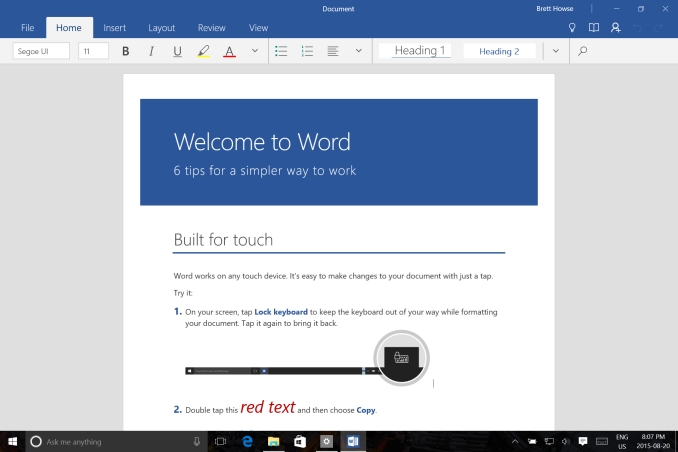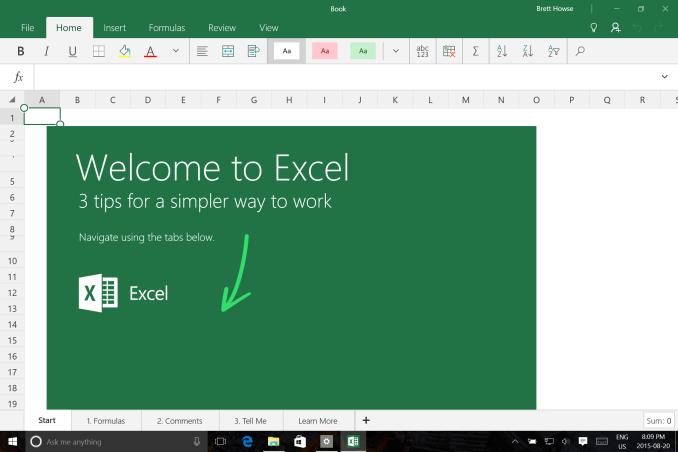The Windows 10 Review: The Old & New Face of Windows
by Brett Howse on August 25, 2015 8:00 AM EST- Posted in
- Operating Systems
- Microsoft
- Windows 10
Touch-Enabled Office Apps Arrive with Windows 10
When Windows 8 launched, Microsoft had built a touch-first version of their operating system, but they had not yet completed their touch-enabled version of their most popular productivity suite. In fact, in the almost three years between Windows 8 and Windows 10, Microsoft released Office on iOS first, and then Android, leaving their own platform as the only one without a touch-enabled version of Office. Finally, with Windows 10, Office Mobile is here.
These are, like practically all pieces of Windows 10, Windows Universal Apps, and therefore they are made to scale all the way from a phone to a large display desktop. Word, Excel, PowerPoint, and OneNote are all available. The experience is very similar to how it looks on the other platforms, and Microsoft has done a nice job keeping the look and feel consistent across the different mobile operating systems.
I think most people are familiar with the Office trio of Word, Excel, and PowerPoint, and perhaps not quite as familiar with OneNote, but the mobile apps are surprisingly competent versions, and can likely easily replace the full Office suite for a lot of people. If you need some of the extra functionality like conditional formatting in Excel, or the ability to open password protected documents, you will need to go with the full version of Office, at least for now.
In pretty typical Microsoft fashion, the apps have been created to allow basic file reading, creation, and editing for free, but if you want to access all of the features you need to purchase an Office 365 subscription. There is a big caveat here though. This only applies to devices under 10.1 inches in screen diameter. Anything larger than this requires a subscription to gain access to edit, which is a pretty big concession. According to Microsoft, they want to keep the free capabilities available for devices that are mostly used with touch, and the Office team feels this cut-off is 10.1 inches. Amazingly, the same company also sells a consumer version of their tablet line, the Surface 3, which is a 10.8 inch device and therefore over the cut-off. They do sell it with a one year subscription, but it’s a rather odd way to market the new Office Mobile apps.
There is also a new piece to the Office puzzle, which is called Sway. Luckily, like OneNote, Sway is free for all users. So what is Sway? It is an interactive storytelling app, and it lets you easily add some text and media, and it will create a sway for you. It’s very much a cloud based app, and you can share links to your sway to view or edit. Think of it like a simpler version of PowerPoint. Here is a sway as an example of what it can do.
OneNote is of course back, and this is Microsoft’s app which lets you do a lot more than just take notes. The touch version is changed from Windows 8, and it now fits in with the theme of the other Office Mobile apps. Fans of the Windows 8 version’s radial menu will be disappointed though since that has gotten the axe.
I think the capabilities of these apps are going to improve over time, but it is unlikely they will ever offer the full functionality of the desktop version of Office. They are targeted towards a different set of needs. It was certainly one of the key missing pieces of the Windows 8 era, so it is great that they have made their debut with Windows 10. Only OneNote is installed out of the box, and the other apps can be found in the store.














293 Comments
View All Comments
bigboxes - Wednesday, August 26, 2015 - link
Please stop. You've made your opinion perfectly clear. However, you don't need to spam up the comments section. You're don't have the only opinion. I may even agree with you on the ultimate fail of Win10, but you're not helping your cause any by repeatedly saying the same thing.tonytroubleshooter - Tuesday, August 25, 2015 - link
Gotta love WIndows.. i dont understand, if a GUI lets you click an icon so you dont have to open it, and a shortcut icon can take you to that icon, then WTF else do you really need in a GUI? not more shortcuts to shortcuts... but I guess i am wrong... so wrong.. .lol oh yeah libraries.. oh my god dont get me started on those, : takes a shot of vodka ; for shame Microsoft for shame....tonytroubleshooter - Tuesday, August 25, 2015 - link
CORRECTION:if a GUI lets you click an icon so you dont have to type it out**
Norzman - Tuesday, August 25, 2015 - link
You need to correct the line about there not being folders in the Windows 10 start menu under "All Apps". Both of my windows 10 machines have folders in the start menu apps list. It looks like this http://imgur.com/tBwwg6RBrett Howse - Tuesday, August 25, 2015 - link
Thanks for that I've re-worded the text.uhuznaa - Tuesday, August 25, 2015 - link
To be honest, I (finally!) like the direction MS is going here, with the possible exception that there is still too much cruft they didn't toss out. OK, MS is cursed with having to provide 20 years or so of backward compatibility, but Windows had grown into an unmanageable mess.There's still lots of work to do, but this is the first time in a very long while that I think MS is going somewhere instead of stagnating and sooner or later being left behind. MS can count itself lucky that Google did never even try to make Android more suitable for desktops or things would have looked much, much worse for MS meanwhile than they do. Sometimes I really think Google knows very well that with a bit of work Android could be on the way to World Domination and they deliberately let this slip (apart from smartphones) just to not find themselves in a nasty monopoly situation a bit further down the road. I mean, if they had just added a cleaner model for third-party drivers, better mouse/keyboard support and multitasking/split-screen support and I guess half of the usual desktop computers could just as well be replaced with Android on ARM machines now. And in fact despite all the security/privacy shortcomings in Android it's still far ahead compared to Windows.
All the PC-nerds here stuck in the good old times will never understand this, but from the POV of modern mobile OS'es the usual PC environment is a nightmare. Little to no sandboxing, little to no rights management for apps ("programs" for you) and hardware... The fact that every bit of code on a PC still can access the microphone and camera and happily read all files in reach really feels like a thing of the distant past in 2015.
Ananke - Tuesday, August 25, 2015 - link
If Google make Android a full desktop OS, they will end up paying so much royalties to MS, that MS will actually make more money that way, instead of selling its own products. Even now, MS is the biggest monetary beneficent of Android anyway. Btw, another reason to not have good accessories support in Android - MS holds so many patents in that area. Why do you think MS is in the business of keyboards, mice, cameras, game controllers etc etc input devices ? It holds patents and collects royalties. Hefty royalties.chrome_slinky - Wednesday, August 26, 2015 - link
It is that way only because no one has the balls to go to court. No one has PROVEN that they own any of what is in Android.uhuznaa - Wednesday, August 26, 2015 - link
Technically Android already DOES support USB- and BT-keyboards and mice. What lacks is the basic comfort of shortcuts, context menus and (international) keyboard layouts. I doubt that this would conflict with any (more) MS patents, especially since even every Linux desktop offers lots of convenience here... And isn't there split screen support in Android M now anyway?Also, I'm not talking about "a full desktop" OS. I'm talking about supporting convenient, basic support for using the bloody thing on laptops and desktops. It would be more of a "full desktop OS" than ChromeOS (which doesn't seem to cause too much patent trouble for Google by the way), but less than Windows. Android lacks just very little here, but what it lacks still makes it a bad choice for anything you use mainly with a keyboard and a mouse.
brucek2 - Tuesday, August 25, 2015 - link
Has Microsoft made any (binding, enforceable) promises about functionality that is currently free / included going premium subscription in the future?Because of the aggressive promotion, initial no charge, and very one sided rules about no consumer control of updates, I am concerned that the ultimate plan is for Win 10 to start charging monthly fees for ever-increasing subsets of functionality. The early example is solitaire, formerly free in previous Windows versions but now requiring a monthly fee. I don't care about that game in particular but MS has plenty of levers it could move that I do care about: i.e., "premium" charges for running more than X apps at a time, or using more than Y GB of RAM, or using disk speeds above 100 MB/sec, etc etc etc.
What if anything is to stop them from a "boil the frog" approach where the update that is initially free is soon $25/month or more for the same level of functionality within a couple years?